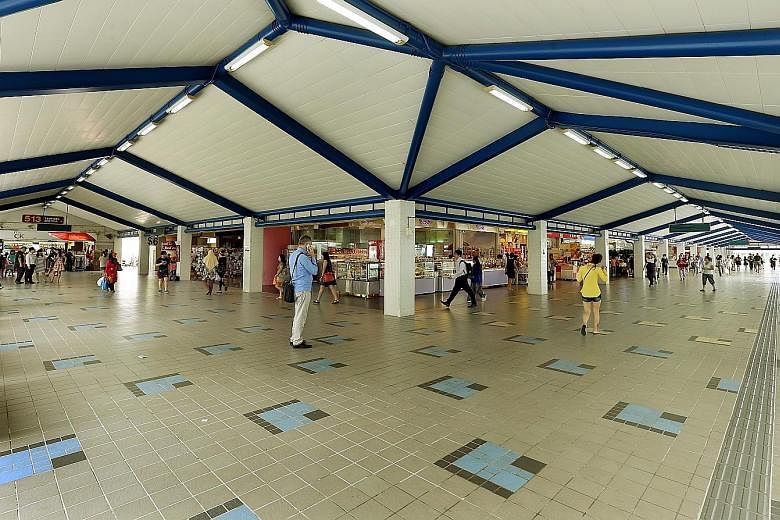Bedok Reservoir resident Genie Lam will be one of the thousands of people living in the eastern neighbourhood who will finally have a train station near their homes.
On Oct 21, the third stage of the Downtown Line (DTL) will open, with 16 stations running from Fort Canning to Expo, passing through neighbourhoods, such as Geylang Bahru, Kaki Bukit and Bedok Reservoir, that have never been served by the MRT system.
The opening of this 21km-long stretch will mark the completion of the three-stage DTL. The final phase adds to the 18 other stations along the line that have been opened in two phases since December 2013.
Altogether, the 34 stations will provide a direct connection between the north-western areas of Singapore, like Bukit Panjang, and the eastern tip of the island.
The average daily ridership for the first two stages was 245,000 in the first quarter of this year. The figure is expected to rise to 500,000 when the full line is up and running.
Miss Lam, for example, will get 20 minutes more spare time once the line opens. Her one-hour commute to her workplace in HarbourFront - which includes a bus and two train transfers - will soon take only 40 minutes with just one train transfer.
"Maybe I can have a good breakfast before leaving home, instead of rushing out," said Miss Lam, 20, an intern with Resorts World Sentosa's events department.
Ms Steffi Lee, 25, who lives in Upper Changi, which is currently not served by the MRT system, is also looking forward to the DTL3.
From the DTL3's Upper Changi station, the corporate communications officer has a direct ride to Bayfront station. From there, she needs to walk only five minutes to her Raffles Place office.
"I'm pleased. I can wake up later. The train will be more reliable than the bus, which is sometimes delayed. I can also take the DTL3 to Bedok North to visit my boyfriend, who lives nearby," she said.
A NEW WAY HOME
A total of 58,000 households will benefit from the DTL3, as they are within a 10-minute walk from one of the 16 stations.
This means 809,000 homes, or 64 per cent of all households, will now have convenient access to the rail network, from 60 per cent now.
This is another step towards the Government's target to have eight in 10 households living within 10 minutes of a train station by 2030 - a key pillar in its car-lite drive.
In fact, Ms Gillian Giam, 46, might consider giving up driving, especially on days when there are road accidents or jams along her route.
The instructor at Motionwerkz, a yoga studio at CT Hub in Kallang Avenue, said: "The new Bendemeer station will make it easier for me and the students to come to the studio. I live in Hume Avenue, so with this new station, perhaps there are days when I can consider taking the train from Hillview straight to work."
National University of Singapore transport researcher Lee Der-Horng told The Sunday Times that the DTL3 bridges the gap between the existing North-East Line (NEL) and East-West Line (EWL).
"Areas such as Jalan Besar, Bendemeer and Geylang Bahru (lie) in between the two MRT lines, and are fairly mature and densely populated. Taking the NEL and EWL may not be so convenient," he said.
The DTL3, he added, traverses a "good mixture" of areas, from industrial spots such as Kaki Bukit and Ubi to residences in Bedok North and Tampines.
BOON FOR SCHOOLS
For students such as 22-year-old Ariella Lim, the DTL3 is a boon as well. The Singapore Management University undergraduate lives in Hillview and usually takes the DTL to Newton, before changing to the North-South Line to Dhoby Ghaut.
"The Bencoolen station (exit) leads right into the school... Previously, it takes more than five minutes to walk from Dhoby Ghaut. My journey is also cut from about 45 minutes to just over half an hour."
Other schools that will benefit from the new stations include the Nanyang Academy of Fine Arts in Bencoolen, Stamford Primary School near Jalan Besar, Canossa Convent Primary School near Mattar, and Maha Bodhi School and Manjusri Secondary School near Ubi.
Similarly, 40-year-old teacher Vanessa Su, who works in an education centre at Liang Court, said the Fort Canning station will be a great help to both employees and customers in the area.
"The MRT is just a five-minute walk away, compared with 15 minutes from Clarke Quay, so it is definitely a good transport option for me," she said.
Travelling between the city and the fringes will also become easier.
According to data from the Land Transport Authority, the current trip from Fort Canning to Marina Bay by bus takes 35 minutes, but with the DTL3, it will be a quick 15-minute ride.
Besides the DTL3's connectivity, commuters can also get to the stations more easily, thanks to 29km of sheltered walkways linking nearby areas to the new stations.
Madam Ng Lan May, 55, a childcare teacher who works at Shun Li Industrial Park, said that from one of the exits of the DTL3's Kaki Bukit station, she can easily walk to her workplace. "Currently, I have to cross an overhead bridge from the bus stop. It's not easy for some of the older workers," she added.
EASY ACCESS TO SHOPS, BUSINESSES
With DTL3 stations like Jalan Besar, people can easily visit the hipster cafes in the area or watch a football game at the sports complex.
Meanwhile, the new station at Ubi will mean convenience for those heading to the high-rise light industrial buildings there.
Businesses also stand to gain, such as the food stalls around Jalan Besar, which will now be accessible by train.
Ms Chin Yu Teng, 22, who helps out at her family's stall, Sungei Road Laksa, said: "These stalls used to be in a very 'ulu' (remote) area, but more customers can come now. Usually those who come are tourists who walk around and get lost, or residents who live around the district. The new Jalan Besar station five minutes away will be good for business."
Her sentiments were echoed by Mr Lim Her-Yi, 33, owner and chief baker of Bud of Joy Organic Bakery and Store.
"For customers who take public transport, they no longer need to face the elements, such as rain or the hot sun, to reach our shop."
This is because the exit of DTL3's MacPherson station will be just outside the shop, he said. In contrast, the existing Circle Line exit is a 15-minute walk away.
He added: "Customers living in Bukit Timah, Bedok, Tampines and many other areas can also reach our bakery without any hassle."




